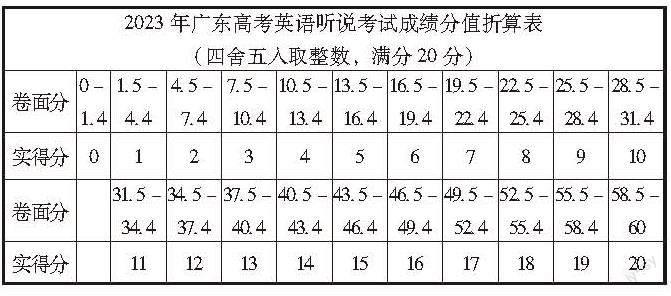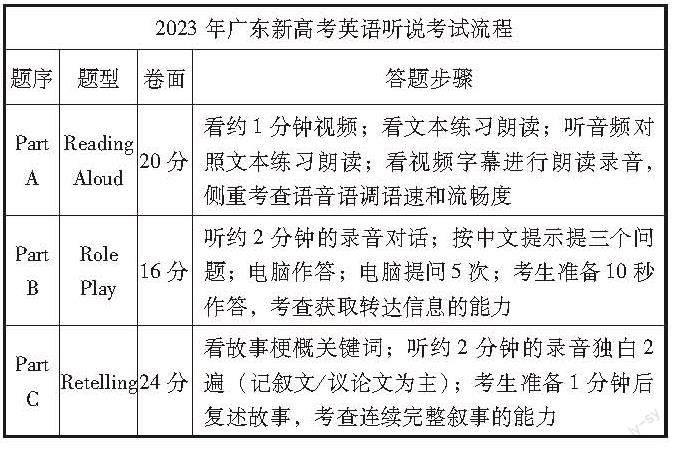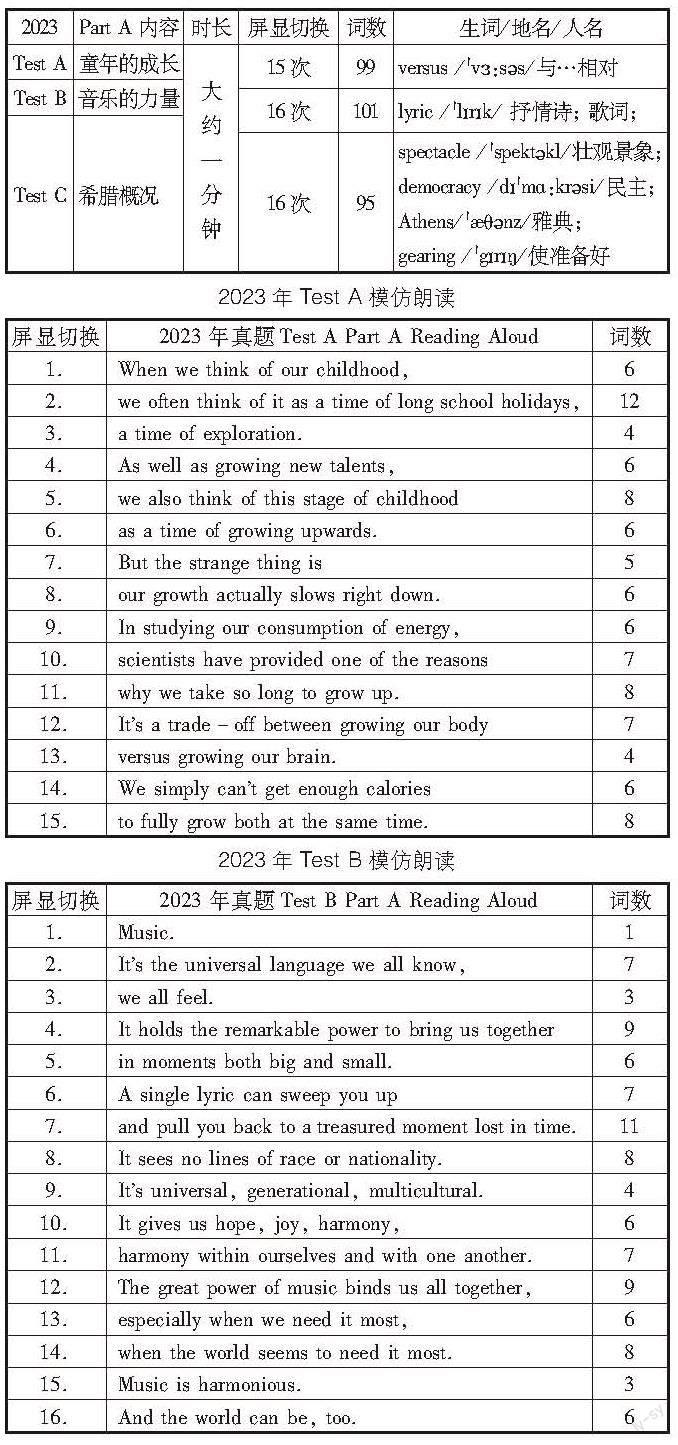基于云平台的高中英语听说可视化教学策略研究
2023-08-02吕少曼
吕少曼



广东英语高考听说考试采用机考形式并由机改评分,高三考生每年3月参加口语考试。自2021年起,广东高考英语听说由15分增加至20分,考试题卷面为60分,最后以20分计入高考英语单科成绩;高考英语科目笔试部分采用新高考全国I卷,分值则减为130分,考生最终的英语科成绩=高考笔试成绩+英语听说成绩。即高考英语科总成绩(满分150分)=笔试折算成绩(卷面成绩×13÷12,满分130分)+听说考试折算成绩(卷面成绩÷3)。
2023年1月16日,《关于广东省普通高考英语听说考试第二节角色扮演试题呈现形式优化的通知》公布:自2023年起,广东省普通高考英语听说考试第二节角色扮演(Part B Role Play)的试题呈现形式将做出部分优化:由“看视频听录音”调整为“直接听录音”,3秒倒计时后直接播放录音,其余不变。
笔者以2023年广东高考英语听说考试真题为例,基于南海区学案教学云平台,在平板创新班以学案导学,以学定教,进行基于云平台的高中英语听说可视化教学策略研究。
一、基于云平台的高中英语听说可视化教学策略
(一)Part A Reading Aloud模仿朗读
Part A视频一般来源于BBC/Discovery/NG等纪录片,屏显一般不会出现三行字幕,朗读时注意字幕断行不等于意群停顿,常出现地名/人名,超纲词汇一般少于三个。
看视频时注意升降调、意群停顿、连读、轻重读及感情色彩,速记生词音标并跟读;看文本时要熟悉标记的生难词发音;听录音模仿跟读时要验证生难词发音,语速跟音频一致。录音时要自信声音响亮,若有单词读错可立刻纠正,屏显切换时未读完部分可凭记忆朗读完整。
2023年Test A Part A
When we thinkofour childhood, we often thinkofit / as a timeof long school holidays , a timeof exploration. As well as growing new talents , we also thinkof this stage of childhood / as a timeof growing upwards. But the strange thing is / our growth actually slows right down. In studying our consumption of energy, scientists have provided one of the reasons / why we take so long to grow up. Its a trade-off / between growing our body / versus [ v :s s] growing our brain. We simply cant get enough calories / to fully grow both / at the same time.
(注: 為重音,/ 为停顿, 为连读,为升调,为降调,[ ]为音标)
朗读易错点: (1) We often think of it. 有读成We often thin(k) of i(t). think中的[ k ]和it中的[ t ]未发音均属准确度和完整度中的吞音错误。(2) But the strange thing is 有读成But the stran(ge) thing(s) is, 其中thing加音s在准确度上属加音错误; strange中的[d ]未发音属吞音错误。(3) the strange中the读[ ]。
(二)PartB Role Play角色扮演
2023年听说真题题材内容侧重跨文化交际。Part B Role Play部分注意事项:1. 对话音频只播放一次,听前应根据情景介绍中的角色和任务,预测对话内容。5W(即who, what, when, where, why)及时间、地点、数字、逻辑关系词所在句是高频考点,可用箭头符号等标记笔记信息间的逻辑关系。2. 三问考查即时翻译造句的能力,先找出中文提示中的疑问词,思考用何种句型、时态语态及助动词和疑问词。翻译须写在纸上,若时间赶也要写下疑问词、助动词等并标好声调,以防录音口误,如一般疑问句用升调,特殊疑问句用降调,选择疑问句前升后降。不懂时也要逐词翻译清晰作答。3. 三问对应的机答录音播放两次。五答时要听清问题和疑问词。五答前两问的答案一般来自录音对话;后三问答案来自“三问”的机答内容(五答提问3源于三问1,五答提问4源于三问2,五答提问5源于三问3)。草稿纸可对折成四个部分来做笔记,第一部分是录音对话笔记,其他三部分对应三问机答笔记。为快速定位答案,可在每段录音笔记后画横线分隔。若回答when, where, how many, how long问题时一般简答完整短语或关键词即可,切勿漏掉介词; 若回答why/ what /how问题时,应用完整句子作答,注意时态、人称、语序、语音等。注意不答无关内容,如thank you, thats all, sorry, I dont know.等等
(三)Part C Retelling故事复述
先看故事梗概预测大意,注意复述时无提示词,应把关键词抄在纸上,听清标题及首尾句以理解主题。平时多练习用符号数字及缩写单词等速记信息,如Tom用T表示,Mary用M,students用Ss,China用CH, week用w, because用∵,more than用>,less than用<,increase用+,否定用×,长时间用——,and用+,mountain用山,people用人。听第一遍录音速记主谓宾及5w信息;听第二遍时补充名词形容词副词等信息,注意人称、时态、单复数及间接引语表述,以串联法复述。漏听内容不惊慌,听不懂时也要翻译出故事梗概,尽量多说。
2023 Test A Part C 视频原文:
A Parcel for Mary
Tom worked in the local post office, responsible for checking lost parcels. One day, he received a call from a little girl Mary who was looking for her parcel. As usual, Tom asked for the checking number. But Mary said she didnt have one. Tom was confused and asked if she knew who sent the parcel. Mary said, “I dont know.” Hearing this, Tom thought Mary must be playing a trick. When he was about to hang up the phone, he heard Mary crying, “All my neighbors are receiving parcels. Where is mine?” To calm down Mary, Tom had a chat with her. Tom learned that Marys family had just moved here and she felt lonely. She was expecting holiday gifts from friends, just like her neighbors. Tom then came up with an idea. He told Mary that he needed her name and address for a double check and asked her to wait. A moment later, Tom told her that he had found her parcel. Later that day, Tom bought some chocolates and a card. On the card, he wrote: “From your friend on the line.” He then put them in a parcel and sent it to Mary.
某生用符号数字及缩写单词等做笔记如下,
A Parcel for Mary
T worked … post office, responsible … checking lost parcels.
1 day, he received a call … girl M who … looking … parcel.
As usual, T asked … checking number.But M said× have 1.
T was confused + asked … who sent the parcel.M said, “I× know.”
Hearing this, T thought M … play- trick.When T→ hang up phone, heard M crying,
“ … neighbors receiving parcels. Where … mine?”To calm down M, T … chat … M.
T learned … Ms family … moved here … felt lonely. She … expecting holiday gifts … friends
T.. came up with 1 idea.He told M … needed name + address … double check + asked … wait.
A moment later, T told M had found … parcel.Later that day, T bought chocol- s + 1card.
On card, he wrote: “From y friend on the line.” He put … in parcel +sent … M.
二、常見错误小结
(一)发音错误 (以2021-2023广东高考英语听说考试真题为例)
1.动词词尾加ed:
(1)在清辅音如[p], [t], [k], [f], [s], [h]等后读[t],如:booked, liked, asked, picked, knocked, rushed, finished, watched, placed, noticed, worked, helped, jumped, stopped, hoped, looked, locked, joked, asked, promised, passed, watched, finished, touched;
(2)在元音或浊辅音如[d], [g], [v], [z], [r], [m], [n], [l]等后读/d/,如:designed, turned, learned, cleaned, returned, happened, frightened, ruined, seemed, moved, received, improved, caused, refused, hurried, admired, bored, tried, offered, treasured, agreed, valued, cried, lied, showed, explored, injured, worried, mentioned, survived, believed, loved, lived, settled, arrived, removed, formed, ashamed, dreamed, learned, planned, opened, turned, complained, filled;
(3)在音标/t//d/后读/id/,如:provided, needed, handed, located, hesitated, painted, wanted, waited, expected, interrupted, voted, hated, started, regretted, donated, disappointed, posted, interested, invited, melted, collected, restricted, pointed, instructed, ended, provided.
2.名词变复数形式或动词变第三人称单数形式时词尾加s:
(1)在清辅音后读/s/,如:giraffes, works, rocks, guests, talents, gifts, chocolates, paints, attracts, tourists, moments, scientists, habits, votes, elephants, adults, sweets, streets, parents, aunts, planets, robots, tasks, books, takes, jokes, months, clothes, crops;
(2)在元音或浊辅音后读/z/, 如: times, rooms, seems, games, begins, paintings, parcels, skills, tools, jobs, friends, holds, binds, crossroads, diamonds, gives, ourselves, holidays, sees, lines, years, neighbors, visitors, slows, operas, makers, users, followers, visitors, years, news, generations, holes, conditions, calendars, workers, rays, days, fields, needs, decades, sounds, kinds, labels, bottles, novels, skills, uncles, cousins, items, tombs, wings, songs;
3.以辅音字母加y结尾的名词变复数形式, 改y为i, 读/ /, 再加上es, 读[z], 如: calorie→calories, story→stories, city→cities, worry→worries,
family→families, activity→activities, gallery→galleries;
4.以o结尾的名词复数形式加es或仅加s, 其读音皆为[z], 如: videos, photos, heroes;
5.读音为/iz/: (1)以s, z, x, ch, sh结尾的词加es, 如:boxes; (2)以ce, se结尾的词加s, 如: performances, experiences,voices, distances, pieces, preferences, spaces, houses, horses;
6.以f/fe结尾的名词复数形式改f/fe为ves,其读音为[vz],如:calf→calves, leaf→leaves;
7. the在辅音音素前读[ ], 如:the robots, the poor, the
wardrobe, the sun;在元音音素前读[ i], 如:the elephants, the earth, the adults, the idea, the elderly, the injured, the ancient Maya.
(二)年份、数字的读法 (以2018-2023广东高考英语听说考试真题为例)
1. 年份: (1)一般将表示年份的四个数字按前后分为两组, 每组按基数词读, 如,1823年读eighteen twenty-three, 1970年读nineteen seventy;
(2)整百的年份则后面两个零读为hundred, 如1900年读nineteen hundred;
(3)十位数位置为“零”时读为字母O, 如1905年读nineteen O five;
(4)千年读法: 2000年读two thousand;45,000读forty-five thousand; 70,000读seventy thousand; 2011年讀two thousand (and) eleven;
(5)三位以内数字的年份按基数词读。
2. 其他真题数字单位考查例举:如, 75%读seventy-five percent;120读one hundred (and) twenty; $5读five dollars; 100 pounds读one hundred pounds; the19th century;12-year-old; five-year-old; Marys twelfth birthday; on the 3rd floor; till 10:30 pm.
三、结语
党的二十大首次将“推进教育数字化”写入报告,加快建设以数字化为支撑的高质量教育体系,是新时代建设教育强国的必由之路。智慧教育平台的建设赋能湾区教育数字化转型,笔者将继续以新高考听说考试真题为例,基于云平台开展高中英语听说可视化教学策略研究。
[本文系佛山市南海区教育发展研究中心及教师发展中心“南海区基于云平台的学案学习与分析实验项目”专项课题“基于云平台的学案学习资源开发与应用探究”(课题立项编号:NHYPT2021004)部分成果]
责任编辑 吴昊雷
